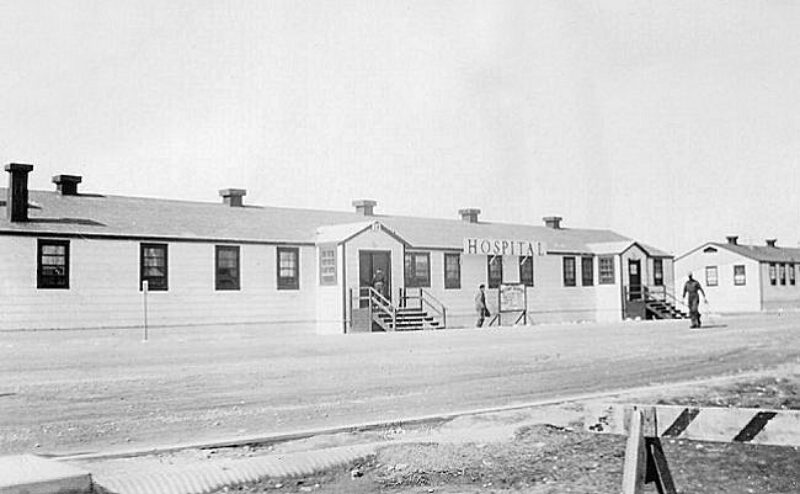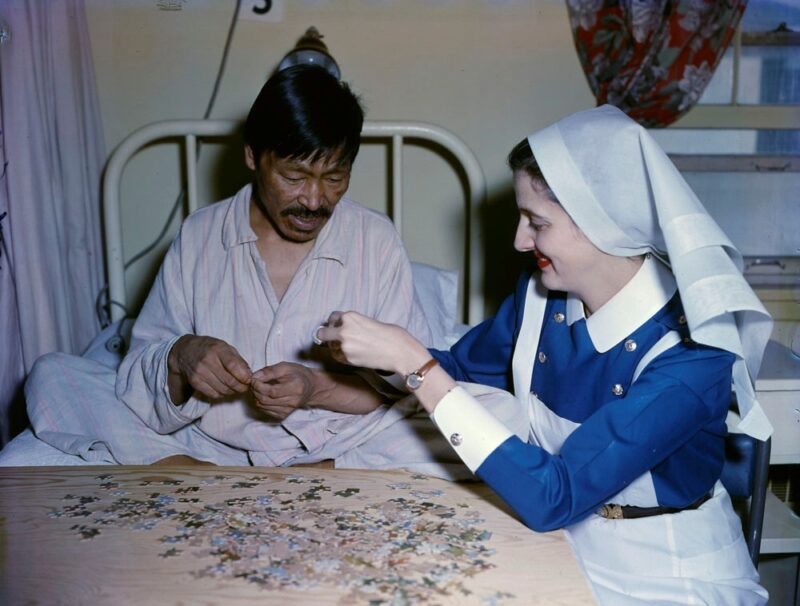Fort Churchill Military Hospital
This page will be updated periodically as our research into records related to patients treated at Fort Churchill Military Hospital continues.
From its establishment in 1948, the Fort Churchill Military Hospital served Fort Churchill military personnel, but also provided medical assessment, care, and treatment to the local community and to both Indigenous and non-Indigenous patients brought in from the Arctic.
Because Churchill was an important waypoint in the transportation of Inuit patients from the Arctic to Indian hospitals and sanatoriums in Manitoba, the hospital may have also treated Indigenous patients in transit. We do know that some patients en route to or from southern hospitals died at or near Churchill. In 1954, an Inuit boy drowned at Churchill while travelling home from the Quebec Immigration Hospital where he had been treated for tuberculosis. A year later, in 1955, a baby who was part of a group of Inuit travelling from the Arctic to southern hospitals in Manitoba died as the group approached Churchill.

Fort Churchill Military Hospital, 1950s, Military Communications and Technology Museum. Photographer: Eileen Jacob.
Where should I begin?
Before you begin your search, read our 'Where Do I Begin?' section of the website, including the Research Tips.
Depending on where your family or community member lived there are several “first stop” sources where researchers can begin. You may also find it helpful to come back to these sources if you have started somewhere else but hit a dead-end in your research.
Your research will take time. And maybe a lot of time, depending on how quickly various organizations respond your requests. Start the process of contacting them and requesting records as early as possible.
Before you contact the archives or records organizations, it is good to have some basic information handy, including:
- names, including any alternates (maiden names, step parent names, nicknames, etc.)
- where you think the person died or where they might be buried
- general time frame, especially an idea of when they may have passed away
You can download a fillable pdf of our Research Checklist here.
This last piece of information is especially important for burial records, which sometimes contain personal health information (eg. the cause of death). In those cases, that record may be restricted, and you may have to wait a certain amount of time after a person’s death to access the records. In Manitoba, death records become unrestricted 70 years after death at which point some of the information becomes available in the Manitoba Vital Statistics online database. See the Manitoba Vital Statistics section below for additional information.

Nursing Sister with a patient at Fort Churchill, Library and Archives Canada, MIKAN no 4234438
1. Sanatorium Board of Manitoba
The Sanatorium Board of Manitoba did not operate the Churchill Hospital, but the person you are looking for may still be listed in the SBM’s Central Tuberculosis Register held at the Archives of Manitoba. Access to records that include information that may identify individual patients is restricted under the Manitoba Personal Health Information Act. To request a search for these these records, fill out and submit a Personal Health Information (PHIA) request
The PHIA request forms are not designed for historical record requests and the form may ask you to provide information or proof that is not available to you. That’s ok. Just fill in the information that you have and indicate how you are related to the patient in question. Please note that information requests for PHIA searches can only be made by the patient or a family member of the patient.
2. The Manitoba Vital Statistics Database
Many of the deaths that occurred at the Fort Churchill Military Hospital were recorded with Manitoba’s Vital Statistics Agency. If the death occurred more than 70 years ago, you can search for the person’s name in the Manitoba Vital Statistics online database. The database is updated every three months, so deaths that occurred between October and December of a year may not be added until sometime after January.
Using this database may be easier if you know a few tricks. You can also find an example of how the database can provide information related to burial sites in our Research Case Study: Manitoba Vital Statistics and Residential School Students.
Note: If you are looking for a family member who may have passed away less than 70 years ago, you can contact the Vital Statistics Agency and ask if you are able to request their death record. They may or may not be able to help in this situation, but you can ask.
3. The Nanilavut Initiative
Inuit patients were frequently treated at the Fort Churchill Military Hospital, either as inpatients or on their way to southern hospitals.
If you are searching for information about an Inuit patient from the Inuvialuit Settlement Region you can request information from The Nanilavut Initiative. The Nanilavut Initiative was established after the Qikiqtani Truth Commission to help Inuvialuit and Inuit from across Canada locate lost loved ones who did not return home after being sent to southern hospitals during the Tuberculosis Epidemic (1940s to 1960s).
News story: In Pursuit of Resolution: Families continue to grieve loved ones who died of tuberculosis in the south (Nunavut News/North, 2017)
4. Government of the NWT: Medical Patient Search Project
If the person you are searching for came from the Northwest Territories, the Government of the Northwest Territories may be able to help you by searching records held by the NWT Archives.
During the last part of the twentieth century, the Government of the Northwest Territories launched a program to help families locate people who did not return following TB treatment. The NWT Government will attempt to help anyone whose family member was sent from the NWT to a southern hospital to locate information if they are able. Contact the NWT Archives here.
5. Manitoba Genealogical Society
The Manitoba Genealogical Society (MGS) has a wealth of cemetery transcriptions, and knowledgeable volunteers. Some of their resources are available online for free, but the best access is provided through purchasing a membership for a small fee.
Members and non-members can search the online Manitoba Name Index (MANI). You may need to try various spellings in your searches. Because many of the patients who died were not memorialized in a published obituary or with a headstone, the online databases may not be as helpful as some of the transcriptions the MGS holds in their collections but that are not included in the online databases. Only members can access the records that appear in the MANI database.
There are regional MGS sites across the province. If you cannot find what you need online and/or cannot attend a regional site, you can hire a volunteer to help you search through the MGS.
6. Library and Archives Canada
We will be adding more information about what is available through Library and Archives Canada (LAC) in the coming months. Broadly, LAC's collections include school files that may be helpful if the person you are looking for was a student at a residential school or sometimes a student at school located in a TB hospital. LAC also holds records of tuberculosis surveys and some hospital admissions. For young people who entered a sanatorium, family allowance records may also be helpful in your search.
Health records, family allowance files, and some school records will be restricted, but you may be able to make a request to see a particular record or records relating to yourself or a person who has passed away. The formal request procedure is explained online here.
What sources can I consult that are specific to the Fort Churchill Military Hospital?
1. Churchill Cemetery Graves Database
In 2014, The Department of Geography at the University of Winnipeg created a plan and database of the marked graves at the Churchill cemetery.
The report includes images of the names on an unmarked graves memorial, marked graves, and shows the locations of unmarked graves.
2. Provincial Hospital Records
It is not clear yet where the records from the Fort Churchill Military Hospital are held. It is possible that there are provincial hospital records that might help you in your search. To do this, make a PHIA request as outlined above for the patient’s hospital records

